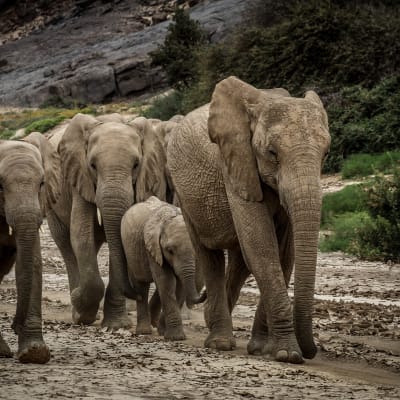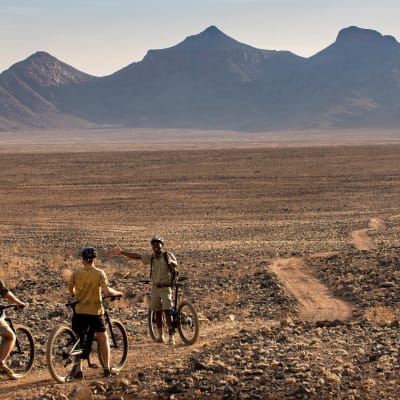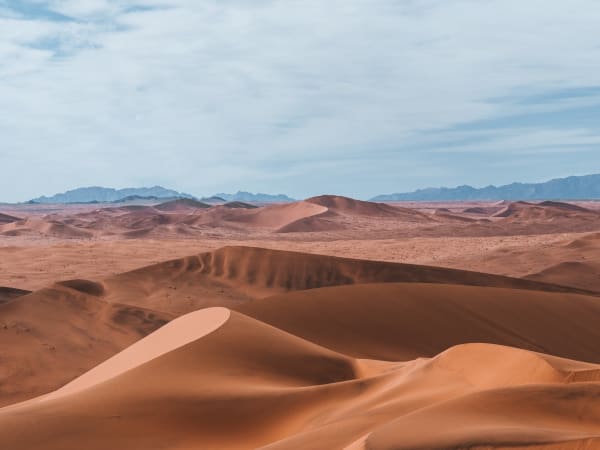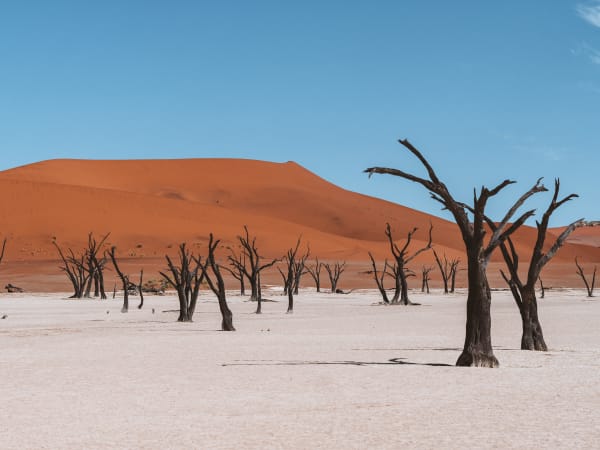
Best time to travel Namibia
Climate, weather and tips for your Namibia trip
Climate, weather and tips for your Namibia trip
Namibia - a country that could not be more diverse. Nature in particular has so much to offer that you can hardly stop marveling and admiring it. And the wildlife also leaves you fascinated. Beautiful coastal towns and the historic capital Windhoek are the icing on the cake. If you want to experience endless deserts, dense forests, rustic mountains, picturesque beaches, dreamlike waterfalls and an interesting culture at the best time to travel to Namibia, you should read on now. Because the two main seasons (consisting of the dry and rainy seasons) bring their own circumstances with them. Well prepared, you will experience your own personal, unforgettable travel experience.
Climate and seasons in Namibia
Namibia offers a climate that travelers can experience in very different ways at different times of the year. Essentially, the year can be divided into two main seasons: the dry season and the rainy season.
Dry season and rainy season
The two main seasons, the dry and rainy seasons, are divided into the summer phase from November to April and the winter phase from May to October. Winter is the dry season and summer the rainy season. The Namibian summer can be correspondingly wet. Most rainfall with short but heavy showers occurs from December to February. At the same time, it is very hot with temperatures of up to 37 degrees, depending on the region it can be more than 40 degrees. In Namibia's winter, on the other hand, it is dry and temperatures range between a pleasant 23 and 27 degrees.
Summer (November to April)
In the Namibian summer, temperatures often rise to 30 to 40 degrees Celsius, especially in the northern and central regions. The rainy season brings the most rainfall from January to March, mainly in the form of short, heavy thunderstorms.
Advantages:
- The landscape is transformed into a green paradise with flowering plants and fuller rivers.
- Wildlife watching is spectacular, as many animals have offspring and the birdlife is particularly active.
Disadvantages:
- High temperatures and increased humidity can be exhausting.
- Some unpaved roads can be difficult to pass due to flooding.
Winter (May to October)
Winter in Namibia, known as the dry season, offers cooler temperatures that can be pleasantly warm during the day (20 to 25 degrees Celsius) and cool to cold at night, especially in June and July.
Advantages:
- Optimal conditions for game viewing as animals congregate around the few remaining waterholes.
- Clear skies and little rainfall make for ideal traveling and photography conditions.
Disadvantages:
- Cool nights and mornings can be uncomfortably cold, especially in the highlands.
- Some tourist attractions and camps are busier.
Transitional periods
The transition months are October and April. October has an average temperature of 20 degrees and is considered one of the driest months. With an average of 18 degrees, April does not differ significantly from October and even though winter officially begins in this month, it is still mostly dry here.
In terms of weather, the best time to travel to Namibia is during the dry season. However, this does not mean that the rainy season has no appeal. All the advantages and disadvantages for the respective seasons are listed in the section "High season versus low season".
Geographical and climatic differences in Namibia
The climatic conditions also depend on the geographical location. This is mainly divided into the desert and coastal regions as well as the highlands.
- Desert: The Namib Desert along the coast is extremely dry all year round. Temperatures here are high during the day and very cold at night.
- Coastal region: The Atlantic coast around Swakopmund and Walvis Bay has a cooler, maritime climate with frequent fog and moderate temperatures that rarely rise above 25 degrees Celsius.
- Highlands: The central highlands around Windhoek have a temperate climate with hot summers and cool winter nights. The high altitude makes for more pleasant temperatures compared to lower-lying desert regions.
The best times to travel by region
Namibia is huge and differs from region to region - so there is a lot to discover. Find out here what special features the individual regions have to offer and when they are best explored.
Namib Desert, Sossusvlei and Deadvlei - dunes and salt pans as far as the eye can see
When red dunes and white salt pans meet, you have arrived at Sossusvlei. The Namib-Naukluft is not only the largest national park in Africa, it also boasts the highest dunes in the world. The three main dunes are Big Daddy, Dune 45 and Elim. The salt pans are called Hidden Vlei, Dead Vlei and Nara Vlei. A seeping river has created a huge area of salt and clay, the cracks of which form a true work of art. Every ten years or so, when the otherwise rare rains come, waterfowl, springbok and antelope find their way here to draw from the waterholes. The best months are May to November with 20 to 25 degrees during the day (but cold nights).
Extreme temperature differences are to be expected in the Namib Desert: While it can get hotter than 40 degrees during the day in the African summer, temperatures can drop so low during the winter nights that frost can occur. In the winter months, it is pleasantly warm and dry at 21 to 25 degrees during the day.
As the Namib Desert also offers a fascinating experience all year round, the best time to visit this part of Namibia depends on individual taste: heat in summer, warm during the day and cold at night in winter. Only the green areas and the one or other flower that blooms in the rainy season make a difference to the scenery.
City life, art and culture in Windhoek
The central highlands of Namibia are located around the capital Windhoek. During the dry season, temperatures average 20 to 26 degrees during the day. At night, temperatures range between 6 and 13 degrees. The months of June and July are considered the coolest. There is hardly any rain during this time, with only a slight risk of precipitation in April. The rainy season is very warm at an average of 27 to 31 degrees, but bearable. Only the high humidity caused by the rain makes it more uncomfortable. This mainly affects the months of January to March. At night, temperatures drop to between 15 and 17 degrees.
Surrounded by mountains, the capital of Namibia offers an idyllic picture, especially from a bird's eye view. In contrast to other parts of the country, you will find built-up districts with a functioning economy. In the township of Katutura, for example, a suburb of the city, there is plenty of art and culture to see. The best time to visit this part of Namibia is during the dry season, with the coolest months being June and July.
Mysticism in the coastal region
The Namibian coast is known as the Skeleton Coast. With the largest ship graveyard in the world and a mix of sand plains and salt pans, the scenery is extraordinary. The climate here is predominantly mild all year round, with the occasional fresh breeze and fog. The water temperatures in the Atlantic are consistently cold.
Shipwrecks and whale bones - the so-called Skeleton Coast got its name for a reason. Cold winds and foggy haze drift over the coastline, creating a mystical picture. National parks and towns such as Swakopmund, Walvis Bay and Lüderitz are among the most popular spots. Seals and desert lions are the animal stars of this region. The year-round mild temperatures also make this area a good year-round destination.
Etosha National Park: White landscape versus green oasis
The biggest contrast in Etosha National Park is its scenery: In the dry season, this area resembles a single white landscape, as the clay settles almost everywhere. The rainy season, on the other hand, allows the plants to sprout. Both variants offer an impressive picture, which is why a visit at either time can be worthwhile.
It depends much more on the conditions at the respective times of year: In the dry season it is very dusty, but the temperatures are in the pleasant twenties. It is easier to observe animals, as you can target the few waterholes to which the animals are drawn. In the rainy season, the roads are often impassable due to flooding. The paths also become longer to find the animals scattered throughout the area. In addition, the heat and sultriness spread. It is advisable to plan your trip for the end of the rainy season. This is when the rain showers subside and it is no longer too hot.
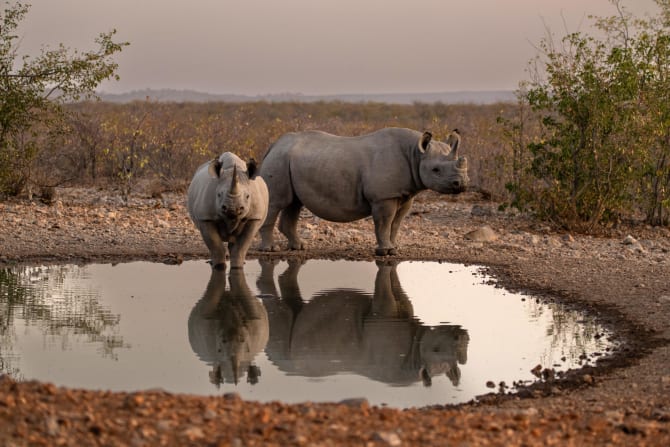
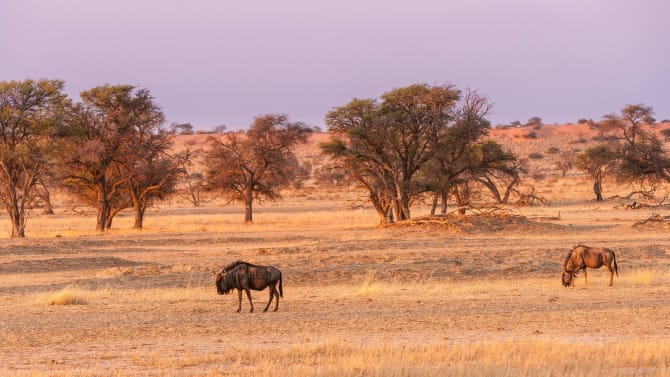
Kalahari Desert in the rainy season
Even though the dry season is generally regarded as the best time to visit Namibia, the rainy season has its own special charm: the heavy rains on the one hand, the magnificent vegetation on the other - that is probably the most interesting difference in the Kalahari Desert. The contrast of salt flats, semi-deserts, forests and beautiful flowers is definitely worth putting up with the odd heavy downpour. The wild animals also go wild at the many newly emerging waterholes, which makes for exciting safari experiences.
Caprivi - a year-round insider tip
The Caprivi region (also known as the Caprivi Strip or Caprivi Strip) in the north-east of the country is considered a little insider tip. Whether in high or low season, this remote area is one of the less visited parts of Namibia, although a trip to the area is very worthwhile. Several national parks with good opportunities for game viewing await you here. The tropical climate allows nature to shine in lush green. It is most bearable in the dry season - to get a taste of the green nature, we recommend the beginning of winter and the end of summer (April to June).
Other activities in Namibia and the best time to visit
In addition to the safari tours in Etosha National Park, the Namib Desert, the Kalahari Desert, the Caprivi Strip and game viewing on the coast, we would like to take a closer look at the desert tours and hikes. At this point you should get an insight into the possibilities of leisure activities and find out what is best for you.
Adventure and outdoor activities
There are plenty of guided hikes, jeep tours and quad bike rides in the Namib Desert. A hike over the red sand dunes is also an absolute must. Hot air balloon rides or flights by helicopter or small plane show the fascinating landscape from a breathtaking perspective. And the Sesriem Canyon with its rustic rock faces also provides an exciting adventure: this gorge bores up to thirty meters deep into the earth. The end of the rainy season and the beginning of the dry season (April to June) are the best times to visit Namibia for such activities: The rain subsides and the heat has not yet reached its peak.
Cultural events
- The Bank Windhoek Art Festival takes place every year in February. While local artists show their works, the surrounding area is enlivened by theater and dance events.
- In May, Africans celebrate their hard-fought multiculturalism at various local venues with Africa Day. This is intended to strengthen coexistence and the joint work of the people.
- The Oktoberfest is also celebrated in Namibia: The former German colony awaits visitors in Windhoek (of course) with lots of beer and fun games.
- On White Flag Day in October, people in the suburb of Ozonde come together in Herero costumes and recite poems in military parades. This celebration is held in honor of the soldiers who fell against the German troops.
Practical tips for your trip to Namibia
Seasonal advantages and disadvantages, photo tips, price examples and tips for choosing clothes - at the end we give you a few tips to take with you.
High season versus low season: the pros and cons
The high season is the period from July to October - which is why this is considered the best time to visit Namibia. Temperatures during the day are in the medium range, i.e. pleasantly warm. It can only get a little chilly in the mornings and evenings. Due to the dry season, there is hardly any rainfall. As a result, the wild animals cavort around the coveted waterholes - which in turn means that people have a good view of the animals. However, both the moderate temperatures and the easier wildlife viewing attract more people.
Advantages:
- Pleasant temperatures
- Dry weather
- Ideal view of animals
Disadvantages:
- More tourists
The low season includes the months of November to March. The days are hot and humid. The rainy season brings corresponding rainfall, which is heavy but short. The rain also brings nature to life - the plants grow lushly and the animals roam wild. However, this also means that the wild animals are more scattered across the vast expanses of land, making animal sightings more difficult. The lush vegetation also obscures the animals from view. On the other hand, there are fewer people around.
Advantages:
- Fewer tourists
- Green landscape
Disadvantages:
- Hot and humid weather
- Heavy but short rainfalls
- Dense vegetation can obscure the view of animals
- Wildlife more difficult to spot as they don't congregate in one place
Price differences for accommodation and flights
To get to Namibia as cheaply as possible, we recommend booking one year in advance. To give you a rough guide, we have listed the Lufthansa prices as an example, taking into account the one-year lead time. This results in prices of 780 euros upwards in Economy Class, 1,050 euros upwards in Premium Eco and 2,600 euros upwards in Business Class. Direct flights are generally more expensive than flights with a stopover.
Accommodation prices vary depending on the standard. The low season from November to March is considered cheaper.
Recommended clothing depending on the season
In addition to summer clothing for the warm to hot regions, you should bring warm or long tops and pants, especially for the nights. Long clothing is also suitable as sun or mosquito protection. Breathable fabrics are ideal in warm temperatures. A waterproof and windproof jacket for rainy days is also recommended.
To be spontaneously prepared for any weather, the classic onion look is helpful: several layers can be easily removed and stowed in the rucksack. Sturdy footwear, including padded socks for hikes and safaris, are important for getting through long walks comfortably and without pain. It also makes sense to wear headgear to avoid sunstroke. Sunglasses with UV protection are also important.
In the wilderness, you should be as inconspicuous as possible, which is why your clothing should be in natural tones wherever possible. Long pants are also advisable in the bush. As you will be out and about a lot, comfortable clothing is advantageous. When visiting restaurants (both in the hotel and out), it is fine to be a little more chic.
Experience the magic of Africa with experts who have explored every corner themselves
Your dream holiday, tailor-made by experts.
Our travel consultants not only admire Africa from afar, but explore the most impressive regions every year to experience the cultures, landscapes and safari experiences first-hand.
From the initial inspiration to the moment you return home full of stories, we will accompany you personally - be it by phone, email or WhatsApp, whenever you need us. Explore the wilderness of Africa, be enchanted by its breathtaking beauty and create unforgettable memories. Together we will create your unique safari adventure!
Experts for your Africa trip


